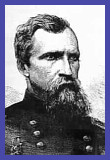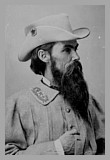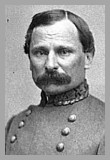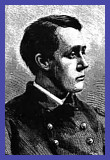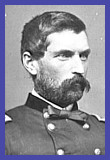| This was
the first in a series of attempts that would be made to
obtain positions astride the vital supply arteries into
Petersburg or Richmond. [Note: In addition to the references listed in the bibliography section of the web site, I have also used here a manuscript which Ed Bearss wrote for the National Park Service many years ago, titled The Battle of the Jerusalem Plank Road, June 21-24, 1864. So far as I know it is still unpublished.] After the failure to take Petersburg the previous week, Grant determined upon a siege, and so orders went out to entrench and fortify heavily. The Corps were arranged from right (along the Appomattox River) to left (near the Jerusalem Plank Road) as follows: XVIII, under W.F. Smith; VI, under Wright; II, under Birney, Hancock having relinquished command due to problems with his Gettysburg wound; IX, under Burnside; V, under Warren. Part of XVIII Corps was posted north of the river, in the Bermuda Hundred lines. With heavy entrenchments in place, the line could be held by a smaller force and the remainder relieved to manuever in the field. To this end, Smith was ordered to extend XVIII Corps to the left to relieve VI Corps, and Burnside was to extend IX Corps to the right to relieve II Corps. Together these would give Grant and Meade a potent manuever force. What Meade intended to do with this force is revealed in a note he wrote Grant after visiting the lieutenant general at his City Point headquarters on June 20th. Birney's men would be withdrawn from their lines that night and massed on the left and rear of V Corps. Once Wright's VI Corps was similarly relieved, the mobile force would advance westward to complete the investment of Petersburg south of the Appomattox River. (Considering the effort that would be expended over the next nine months before that goal was actually accomplished, one is tempted almost to laugh at Meade's optimistic assessment of what he might accomplish.) The infantry expedition would also serve as cover for the launching of a major cavalry raid involving Wilson's and Kautz's divisions (see the article on the Wilson-Kautz raid), who were to penetrate deep behind Confederate lines and destroy railroad track and bridges along the railroads into Petersburg. The operation got under way on the evening of the 20th. Birney, with II Corps, was relieved in the trenches by Burnside and Wright and partially deployed at the Avery house, behind Warren's center. Birney reported to Meade that he was in position at 5:10 a.m. of the 21st, but Meade ordered him to shift to a new position, fully alongside Warren's left and fronting the Confederate trenches, at about 7:15 a.m. Because of the limited roads available to him, this was not an easy move for Birney to make. With only a small cavalry force for reconnaissance in this area, the II Corps commander moved cautiously. After moving to the left until he struck the Jerusalem Plank Road, Birney marched south along the road until he came to the Williams farm, where the road to Globe Tavern on the Weldon Railroad branched off to the west. He massed two of his divisions (under Gibbon and Mott) in some open fields near the Williams farmhouse, and sent Barlow's First Division along the road to Globe Tavern, with the cavalry as a screen, the idea being to develop Confederate strength in this area before deploying II Corps into line. Barlow advanced forward against skirmishers from Barringer's North Carolina cavalry brigade (supported, towards the end of the day, by elements of Cadmus Wilcox's division), but was unable to reach the Weldon Railroad without breaking his connection with the rest of II Corps. (It appears that Barlow thought that Gibbon would be moving out on his right, when in fact Gibbon was back at the Williams farm, just west of the Jerusalem Plank Road.) Despite the fact that Barlow had gotten to within a couple of miles of the Weldon Railroad, Birney recalled him and put the entire corps into line. Gibbon was on the right, connected to Warren, then Mott, then Barlow near the Williams house. Apparently the Federal line ran generally north-south, more or less parallel to but slightly in advance of the Jerusalem Plank Road. Barlow's furthest advance had been reached at about 1:00 p.m., and the entire corps was in line and entrenched soon after dark. Scouts had detected a Confederate column moving across the II Corps front (this was probably Cadmus Wilcox's division moving out to contest Barlow's advance), making Birney cautious about further advances until VI Corps arrived. VI Corps was supposed to have been relieved from the trench lines soon after II Corps departed, but there were delays and problems getting the troops from XVIII Corps into position, and the Rebels apparently figured out that something was up and began to shell the Federal positions in order to disrupt whatever was going on. As a result, it was not until near dark that Wright began to move the bulk of his troops to join Birney along the Federal left. Ricketts's division had been relieved before noon and therefore was able to go into line on Barlow's left soon after dark; the other two divisions (under Wheaton and Russell) did not arrive at the Jones farm, in the right rear of the II Corps position and about a mile and a half north of the Williams farm, until 4 a.m. on the 22nd. On the 22nd, Wright was to strike out towards the railroad (westward) along the road to Globe Tavern. Essentially, the Federals tried to execute a two-corps "swinging-and-stretching" gate operation: VI Corps was supposed to drive towards the railroad, while II Corps filled the gap between the right of VI and the left of V, extending the Federal works. Once the railroad was reached, Wright was to pivot to the right and advance along it towards Petersburg. If the operation had gone as planned, the Federals would have had a close investment of the Petersburg lines extending about three-quarters of the way around the city. The problem was that the Federals did not know the topography very well (despite having been in the area the day before) and were forced to negotiate their way through tough, heavily wooded terrain with poor maps and along a single road. (A significant but often overlooked aspect of the Petersburg siege is the lack of an east-west road network to support large troop movements around the city, outside of the Rebel lines. The only such road available to the Federals in this operation was the road running from the Jerusalem Plank Road to the Weldon Railroad at Globe Tavern, along which Barlow had advanced the previous day.) Largely because the supporting troops moving cross-lots through the woods could not keep pace with the column on the road, but also because the course of the Globe Tavern road diverged away from a line fronting the Confederate works at Petersburg, a gap began to develop between VI Corps and the left-most division (Barlow's) of Birney's line. When Barlow told Meade of this developing problem, he was told to maintain contact on his right with the rest of II Corps and refuse his left, that Wright would have to look out for his own flank. Unfortunately, it was Barlow's flank that would be the one in danger. The advance began before 8 a.m.; late in the afternoon some men from Wright's corps plus a cavalry detachment reached the railroad in the vicinity of Globe Tavern, about three miles south of the Confederate lines, and began tearing up track. Wright's main body was still some distance away. The Confederates had not been inactive and, unlike the Federals, they knew the ground. William Mahone, a division commander in A.P. Hill's corps, had been a railroad engineer in this very county before the war, and it was his division that was given the job of opposing the Federal advance. Cadmus Wilcox was to support him. It was Wilcox who had been sent out from the Petersburg lines the previous day to oppose Barlow's advance. True to his aggressive nature, Lee wanted Mahone to attack and punish the Federals. As he moved out, Mahone was informed of the developing gap between Barlow and Wright, and the Virginian determined to exploit it: while Wilcox confronted and threatened Wright, Mahone would use a ravine that ran through the Federal lines to turn Barlow's flank and smash the entire II Corps. The attack began at about 3 p.m. Gibbon's division of II Corps, being the hinge of the swinging gate, had the shortest distance to move before achieving its final position and so was well posted and entrenched soon after the advance began; however, the other two II Corps divisions were just coming into line, having had to shift to the right to make contact with Gibbon after advancing alongside Wright. (In trying to maintain contact with VI Corps they had drifted too far to the left and were now coming back to the right.) Barlow and Mott had just begun to dig a new line of entrenchments, roughly parallel to the Rebel works, when the blow struck. Barlow had enough warning that he was able to attempt to reinforce his refused left but it was to no avail and after a stiff, but brief, resistence his left collapsed and with it his entire line. Barlow had the presence of mind to order one brigade, under Nelson Miles, to withdraw back to the breastworks built the previous day and endeavor to make a stand, which they did. The disaster did not end with Barlow, however. Because of the wooded nature of the terrain and the brief fight put up on the left, the Federal troops to the right did not find out about the attack until their compatriots on the left came streaming back with Mahone's men on their heels in hot pursuit. Mott's division was unable to offer much resistence before it, too, fell back, but it did so in relatively good order, taking up the line it had held the day before. Mahone had made his attack with the brigades of Sanders, Wright, and Weisiger, in that order from left to right. As the attack progressed, Sanders actually hit Gibbon's line frontally, not in the flank, and so was initially repulsed by the left-most Federal brigade. But when Wright and Weisiger came up in support of Sanders, the Federals were unable to hold, and so Gibbon's division also fell back. (During this attack II Corps lost four guns, the first guns they ever lost except for two that had been deliberately abandoned at Spotsylvania.) The Federals rallied along the Jerusalem Plank road, roughly at right angles to the line they had formerly formed, now extending slightly southeast instead of towards the west. A few feeble attempts were made to re-take their former positions, but these were repulsed. At 10:00 p.m. that night, Mahone's men drew back into their works after drawing off the booty of their success. There were some recriminations on the Confederate side that Wilcox had done nothing but confront Wright and had not attacked him. However this may be, Wilcox's presence had kept Wright from reaching the railroad, although the disaster to Birney would probably have forced him to retire in any case. However, a vigorous push by Wilcox against Wright's right flank -- which was just as exposed as Barlow's left flank -- might have dealt VI Corps an equally crippling blow. The Federal advance was resumed the next day, at about 3:30 a.m. On the II Corps front, the troops advanced to retake the line from which they had been flanked the previous day; this was done against virtually no opposition. By 7:30 a.m., Birney could report to General Meade that Barlow's left had linked up with the right flank division of VI Corps. By 10:00 a.m., General Wright could report that he had gotten a "detachment" onto the Weldon Railroad at Globe Tavern. But Wright was too haunted by what had happened to Birney the day before to follow up this modest success. Before he could advance his entire corps and take possession of Globe Tavern in force, scouts and tree-top observers reported a strong Confederate column headed down along the Weldon Road from Petersburg. This was Mahone, again having been asked to deal with the Federal threat. Instead of moving with only three of his brigades, as he had the day before, the wiry Virginian this day had all five of his own brigades plus one of Harry Heth's. Instead of advancing to meet the enemy, therefore forcing Mahone to respond and deploy, Wright held his position, afraid to advance, and called for help and advice. Meade repeatedly pleaded with his VI Corps commander to advance his skirmishers and main battle line to seize the initiative from Mahone. But all Wright could see were threats to his flank. Ed Bearss assesses the message traffic of this day between Meade and Wright with the comment that it looked like Meade was about to relieve Wright, he was so angry with him. Finally, at about 6:30 p.m., Meade told Wright that he should "either attack or withdraw; the former is most preferable." Still Wright procrastinated, worried in part about a Rebel column that he thought might be trying to turn his left flank south of Globe Tavern. At about 9:00 p.m., after spending the entire afternoon on the brink of cutting the Weldon Railroad, Wright decided to withdraw to the line he had held the day before. The only serious contact with the enemy force had been a brief and embarassing affair in which about 400 men of Wright's advanced picket line had been gobbled up by a brigade of Florida troops. Ironically, this occurred after A.P. Hill had ordered Mahone to withdraw back into the Petersburg lines; at the time Wright made his decision to fall back, he faced no opposition and no threat from the enemy. The new VI Corps line -- actually the same one as the day before -- ran roughly north-south about a mile west of the Jerusalem Plank Road. Perhaps aware of his poor performance on this day -- one of Meade's staff officers wrote that the VI Corps commander "showed himself totally unfit to command a corps" -- Wright had his men moving early on the 24th. By 10:15 he had regained his advanced position of the day before and again had possession of the Weldon Railroad by a small force. Did General Meade want VI Corps to continue the advance? The initial answer from Army of Potomac headquarters was affirmative. Wright's skirmishers were to advance, maintain contact with the II Corps skirmishers on their right, and then the main body of VI Corps should advance. Birney would conform on the right. Before this order could be carried out, however, General Grant -- having learned the extent of the disaster to II Corps on the 22nd -- called a halt to the entire operation. The troops were to strongly fortify their present lines. The affair ended with the Federal line extended beyond the Jerusalem Plank Road, but not as close to the Rebel line as desired and not as far as desired, since the Weldon Railroad was about a mile to a mile and a half in front of Wright's line. Federal casualties are given as around 2,000, with as many as 1,700 being captured in Mahone's attack. Confederate losses are not known in detail; an examination of Richmond and Petersburg newspaper reports allows for an estimate of around 600 killed, wounded, and missing. On this same June 24th, probably in reaction to the Federal efforts south of Petersburg, Lee put into action a plan to unhinge the far right of Grant's line, along the Appomattox River. The Federal trenches here were actually exposed to enfilade fire from Rebel positions on the north bank of the river, and Lee thought that a strong bombardment followed by an infantry assault might lead to a breakthrough that could raise the entire siege. The bombardment was to be organized by Brig. Gen. Porter Alexander, the outstanding First Corps artillerist; the attack was to be carried out by the divisions of Charles Field and Robert Hoke. Unfortunately for the Confederates, there was much confusion between Field and Hoke as to whose troops were to have what part in the attack. The tragic effect of this was that only Johnson Hagood's South Carolina brigade (of Hoke's division) ever moved out, and it was trapped between the lines by Federal fire, suffering over 300 casualties for no benefit whatsoever. The affair along the Jerusalem Plank Road was an inauspicious beginning to Federal siege operations. Although the overall plan was well-conceived, it was poorly executed and suffered from a degree of tactical carelessness that would bedevil the Yankees throughout the next nine months. Meanwhile, the Rebel reaction had been swift, decisive, aggressive, and (therefore) successful. But Mahone's success had not prevented Grant from extending his line closer to the Weldon Railroad; the next such operation would not have as far to go. Lee's decision to launch an aggressive counterstroke against Grant's right is to be applauded in the abstract, but the poor execution showed that his army was no longer the precision instrument he had once wielded to great effect. Moreover, he had seriously overestimated the degree of demoralization in the Federal army to think that a two division attack could raise the entire siege, as he appears to have hoped. |
|
||||||
 |
Return to Siege main page. Return to list of accounts. Go to previous page. Go to next page. |

